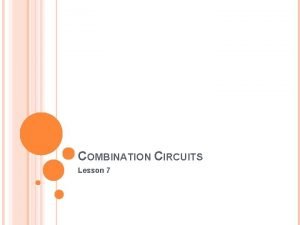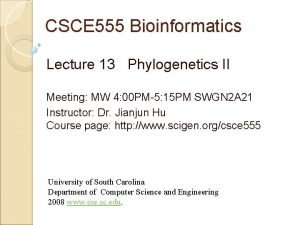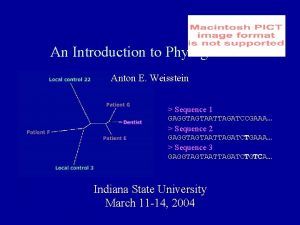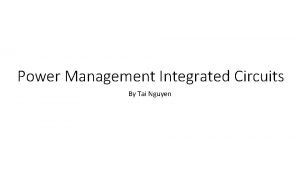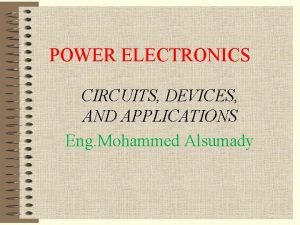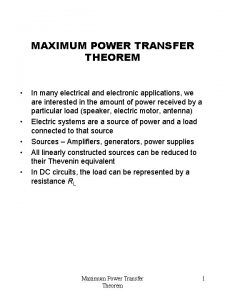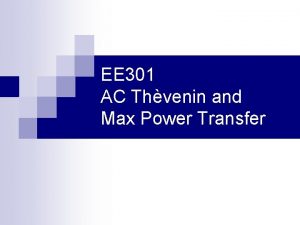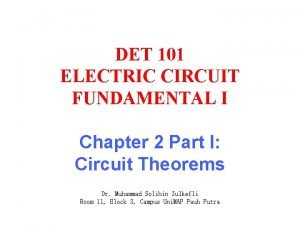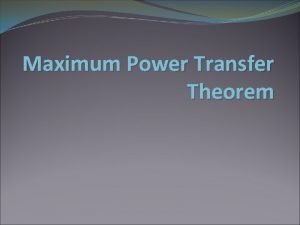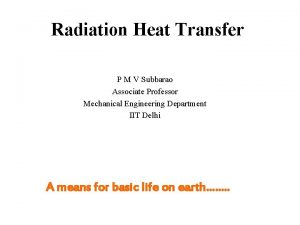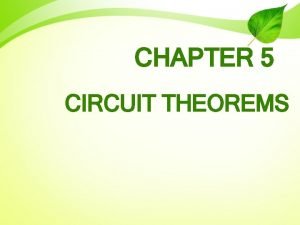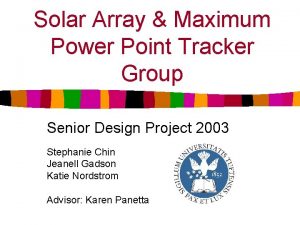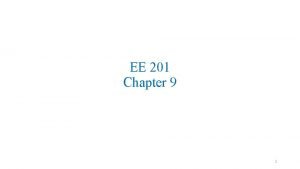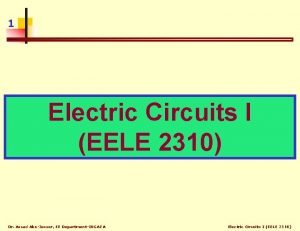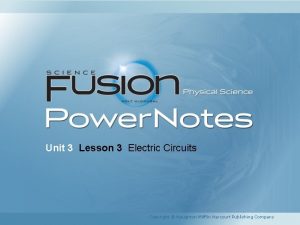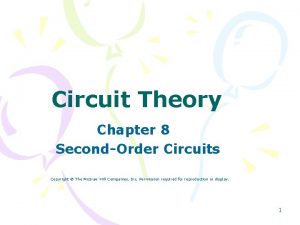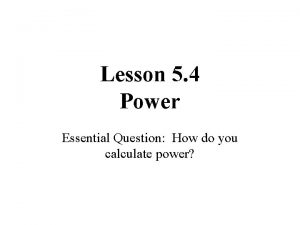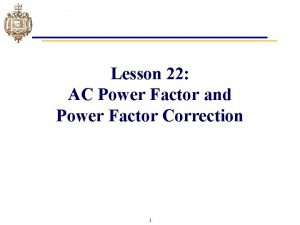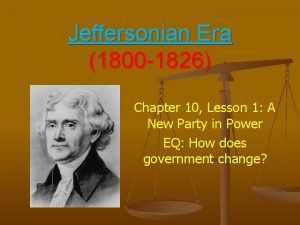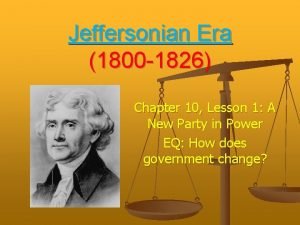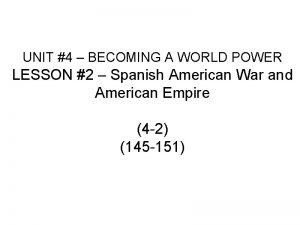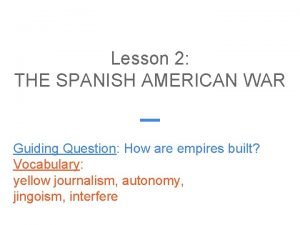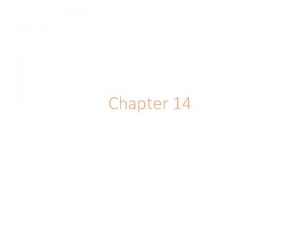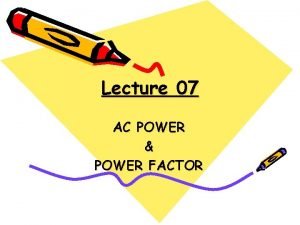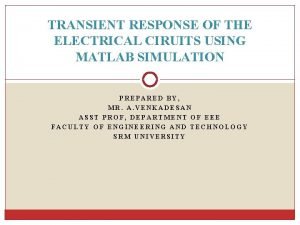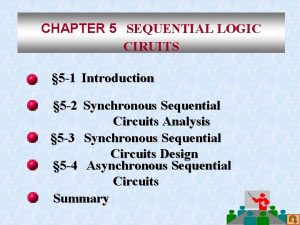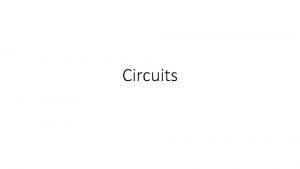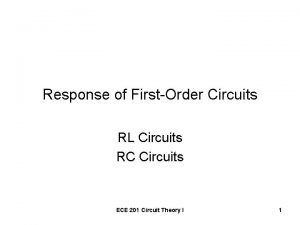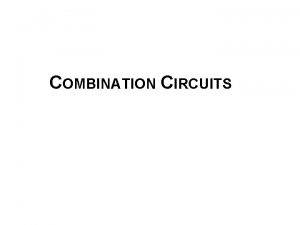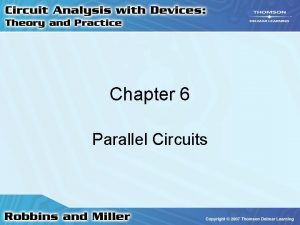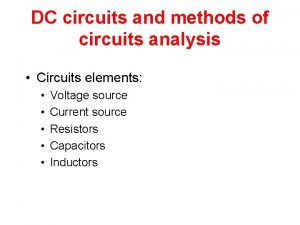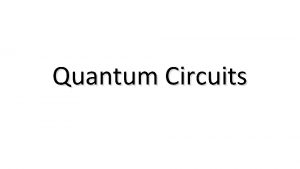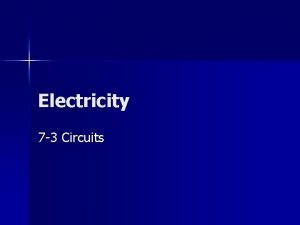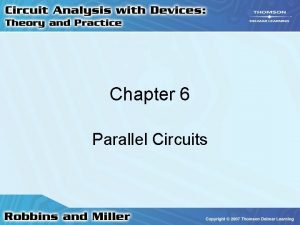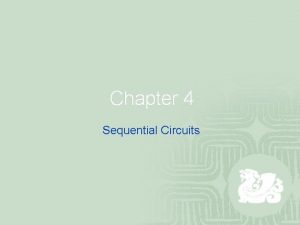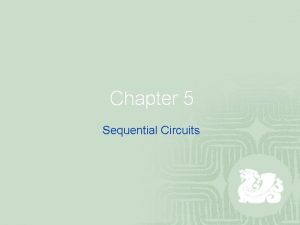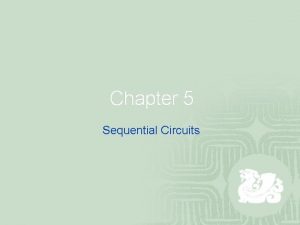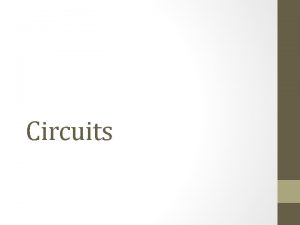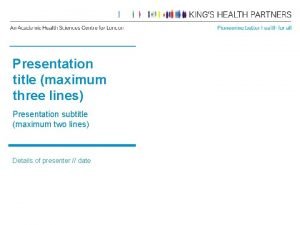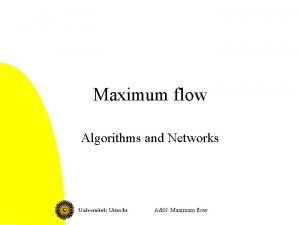Lesson 11 AC Circuits AC Ciruits Power Maximum








































- Slides: 40

Lesson 11 AC Circuits ¨AC Ciruits ¨Power ¨Maximum and Instantaneous voltage drops and current ¨Phasor Diagrams ¨Phase angle ¨RLC Circuits ¨Resonance frequency ¨High and Low pass filters ¨Step up and Step down Transformers

AC Generator

AC emf source

Effective (Integrated ) values of I and V i (t ) = I max sin (w t ) w = 2 pf = rms current 2 p ; T is the period of oscillation T Instantaneous power = i (t )v (t ) Heat dissipated =Power used in load = i ( t ) R = I m R sin (w t) Average power over one cycle 2 Pave = 1 T ò T 1 2 w = ( ) I R sin t dt I m R 2 m 2 T 0 ò P ave 2 m I R w = ( ) t dt sin Define 2 2 T 0 = I rms. R Þ I rms = 2 Im 2 2 2

Alternating Current Circuits

ac-R circuit Veff and v(t) Ieff and i(t) t)

Phasor Diagram Phasor diagram for R i (t) R IRmsin( t)= i. R(t) t Current through Load Resistance

Phasor Diagram Phasor diagram for R cont. v (t) R VRmsin( t)= v. R(t) t PD across Load Resistance

Instantaneous current and voltage

v. C(t) t) ac-C circuit i. C(t) Current in Circuit and PD across Capacitor v. C(t) t

v. L(t) t) ac-L circuit i. L(t) Current in Circuit and PD across Inductor v. L(t) t i. L(t)

Summary The phase angle between the current and the voltage: In the resistor is 0 rad In the capacitor is - rad ( Current Ahead) In the inductor is + rad (Current Behind)

series ac-RLC circuit Series RLC circuit

Instantaneous current Current through all elements is the same Thus the instantaneous PD’s must be out of phase

Picture Total Potential Drop across R, L & C.


Phasor Diagram for RLC circuit I v. L(t) v. R(t) v. C(t)

Instantaneous PD

Phasor Diagram for RLC circuit II v. L(t) v. RLC(t) v. R(t) v. C(t)

Instantaneous PD as y-axis projection onto v(t 2) v(t 1) v. RLC(t)

Phase v. RLC(t) Angle Phase Angle V Lm - V Cm tan (f ) = V Rm I m X L - I m X C X L - XC = = Im R R -1 æ X L - XC ö f = tan ç ÷ è R ø

series ac-RLC graph

Impedance The magnitude of the Total Potential Phasor is V m = V + (V Lm - VCm ) 2 2 R = I R + (Im X L - Im XC ) = I m R + (XL - XC ) 2 m 2 2 = Im Z Impedance : Z = R + (XL - XC ) 2 2

Table of definitions

Impedance and reactance

Generalized Ohm's Law. Impedance Z = R + (XL - XC ) 2 2

Phase Angle between total PD across circuit and the current

Power is only used in AC circuit in load resistance 2 ( ) P t =i t R Power Factor (energy is not used in inductor or capacitor) 2 2 = I m sin (w t - f ) R (current is always in phase with PD across total resistance) P ave æe ç rms ç Z è ö ÷ I rms R = ÷ ø 2 m I = = I R R 2 ß e 2 rms I rms R= Z e rms I rms cos( f ) cos (f ) = Power Factor

Power and current Angular frequency depend on angular dependence frequency of circuit

I m (w ) = Vm Z (w ) = e m Z (w ) Max I ; Min Z Z (w ) = R + (X L - X C ) 2 æ 1 ö ÷ = R + ç w. L è w. C ø 2 = 2 Z (w ) is a minimum when 2 2 2 æ ö w LC - 1 2 ÷ R +ç w. C ø è w 2 LC - 1 = 0 which occurs when 1 w = w 0 = LC Û X L = XC

Power as a function of 2 Vm R 2 1 1 Pave (w ) = I m (w ) R = 2 2 2 Z (w ) 1 = 2 2 Vm R 2 1 Vm. R 2 = 2 æ ö L 2 2 2 1 2 ÷ R + ç w. L R + 2 (w - w 0 ) è w w. C ø 2 2 1 V m Rw = 2 2 2 2 R w + L (w - w 0 )

Resonance Circuit uses most power / current when it is in RESONANCE with applied frequency

Imax and Pave versus Pave Im

¨Width of Power curve is a measure of the QUALITY of the circuit ¨Small width - High Quality ¨Sharpness of response to external frequency Quality of circuit

RC Filters I Low Pass Filter Vout Vin

Low Pass Filter

RC Filters II High Pass Filter Vout Vin

High Pass Filter

Step up and Step Transformers I down Transformers

V V Transformers II F d 1 = - N 1 2 = - N 2 B dt d FB dt Fluxes are the same N 2 = V 2 V N 1 1
 Combination circuits
Combination circuits Advantages of parallel circuit over series circuit
Advantages of parallel circuit over series circuit Lesson outline lesson 3 describing circuits answers
Lesson outline lesson 3 describing circuits answers Absolute maxima and local maxima
Absolute maxima and local maxima Maximum parsimony vs maximum likelihood
Maximum parsimony vs maximum likelihood Maximum likelihood vs maximum parsimony
Maximum likelihood vs maximum parsimony Draw power triangle
Draw power triangle Power management integrated circuits
Power management integrated circuits Power electronics circuits devices and applications
Power electronics circuits devices and applications Maximum power transfer theorem
Maximum power transfer theorem Maximum power transfer theorem
Maximum power transfer theorem Thevenin equivalent circuit examples
Thevenin equivalent circuit examples Maximum power transfer calculator
Maximum power transfer calculator Monochromatic emissive power formula
Monochromatic emissive power formula Find vo using thevenin's theorem
Find vo using thevenin's theorem Photovoltaic array maximum power point tracking array
Photovoltaic array maximum power point tracking array Maximum power transfer theorem
Maximum power transfer theorem Maximum power transfer
Maximum power transfer Lesson 8: comparing series and parallel rlc circuits
Lesson 8: comparing series and parallel rlc circuits Describing circuits lesson 3 answer key
Describing circuits lesson 3 answer key Lesson 8: comparing series and parallel rlc circuits
Lesson 8: comparing series and parallel rlc circuits Solar power satellites and microwave power transmission
Solar power satellites and microwave power transmission Actual power
Actual power Flex28024a
Flex28024a What is dispersive power of plane transmission grating?
What is dispersive power of plane transmission grating? Power of a power property
Power of a power property General power rule
General power rule Power angle curve in power system stability
Power angle curve in power system stability Power bi power point
Power bi power point Power absorbed or supplied
Power absorbed or supplied Lesson 5 how to calculate power
Lesson 5 how to calculate power Power factor lagging means
Power factor lagging means Chapter 10 lesson 2 the louisiana purchase
Chapter 10 lesson 2 the louisiana purchase Chapter 10 lesson 1 a new party in power
Chapter 10 lesson 1 a new party in power Chapter 10 lesson 1 the jefferson era
Chapter 10 lesson 1 the jefferson era Becoming a world power lesson 2 the spanish american war
Becoming a world power lesson 2 the spanish american war Chapter 5 lesson 2 the spanish american war
Chapter 5 lesson 2 the spanish american war Becoming a world power lesson 3 new american diplomacy
Becoming a world power lesson 3 new american diplomacy Lesson 3 enlightened absolutism and the balance of power
Lesson 3 enlightened absolutism and the balance of power Informal powers of the president
Informal powers of the president Lesson 2 power factor correction
Lesson 2 power factor correction
